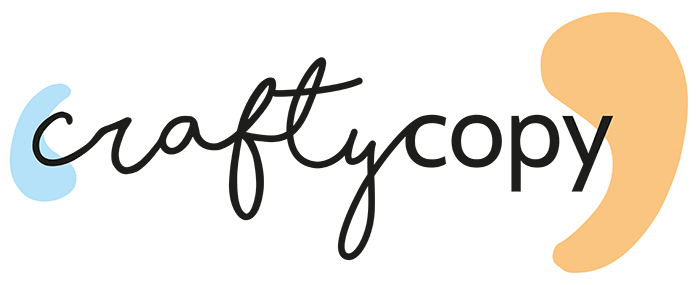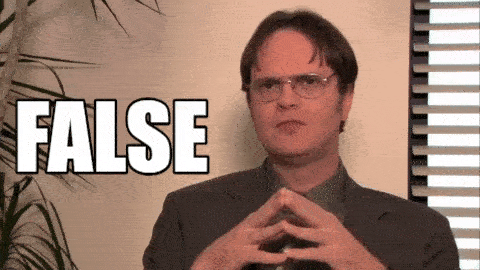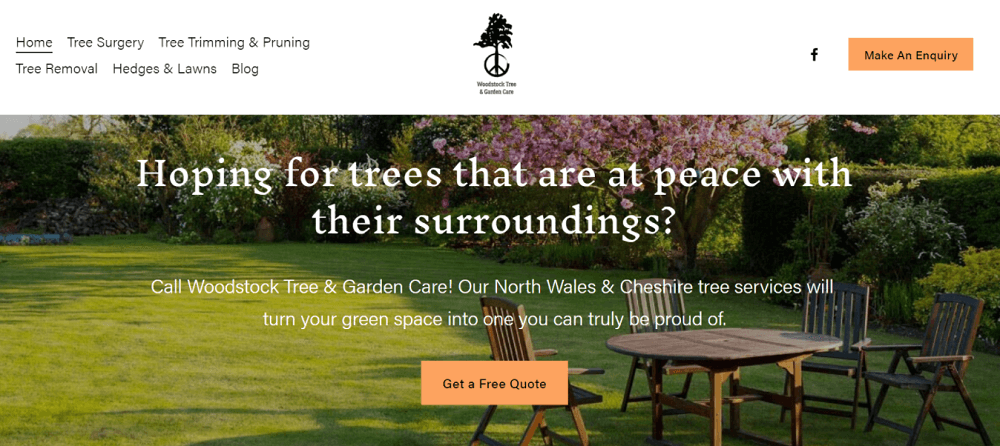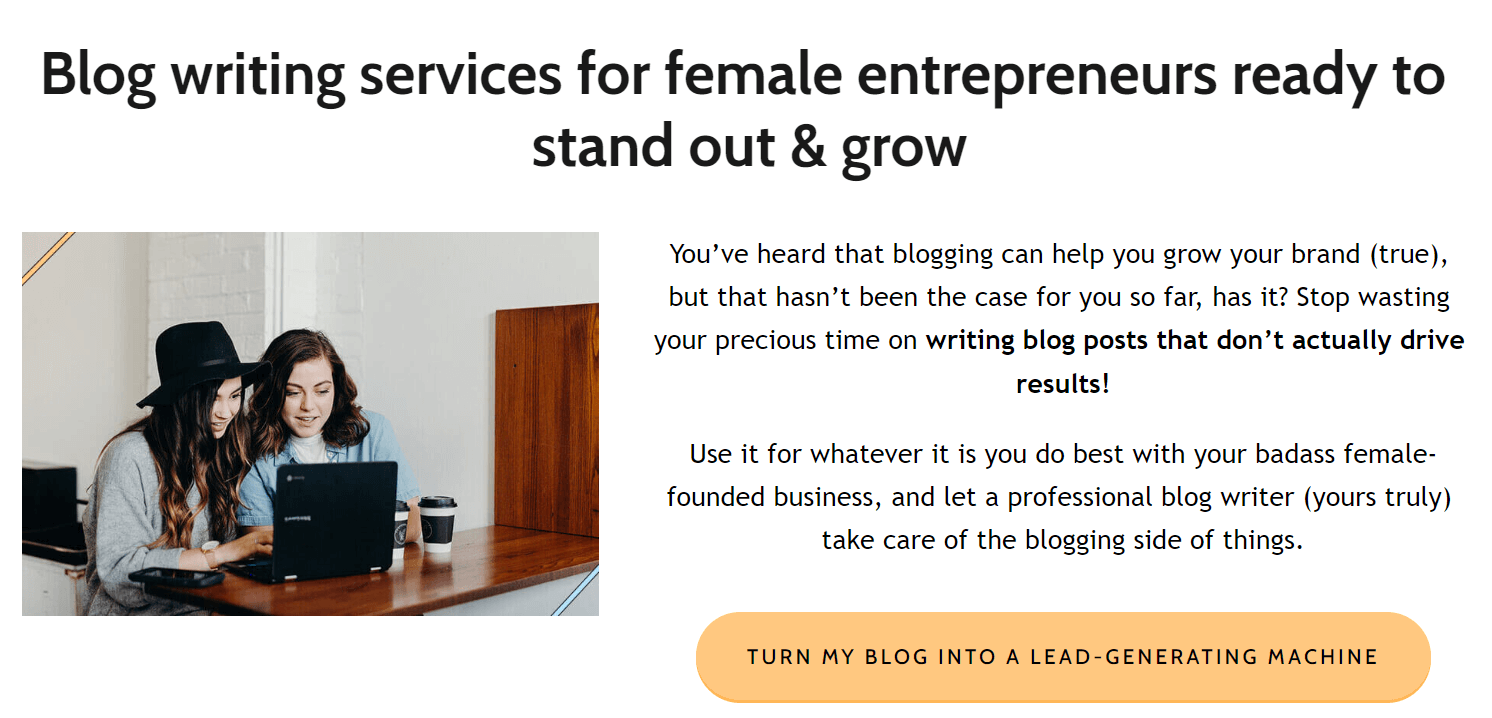Content Marketing Myths Hurting Your Business (Ouch!)
‘Blogging doesn’t work.’ ‘We must post company news.’ NOPE! Let’s debunk the content marketing myths that have been actively damaging your female-founded biz.
A networking conversation or even a quick scroll down your LinkedIn feed are probably enough to bring out some of these harmful content marketing myths.
Oh, we’ve tried blogging, but it didn’t work.
Content? That’s a waste of time.
Well, for anyone who actually thinks so, let me cut to the chase: if content marketing didn’t work for you, you were simply doing it wrong.
In fact, did you know that a whopping 70% of marketers (including yours truly) are investing in content strategies? We can’t all be wrong, now, can we?
Before tackling these content marketing myths, let’s start by making sure that we’re on the same page.
What is content marketing?
Content marketing is a marketing strategy consisting of the creation of online pieces (like blog posts, videos, or social media posts) that bring value to a brand’s target customers.
While they’re not directly promoting the company, they actively help it generate more leads, grow its audience, and establish itself as an expert in its field.
We’ll be looking at the main content marketing myths that are probably costing you money, but let me get another misconception out of the way first: content marketing is NOT the same as copywriting!
Copy is a marketing or advertising text written to sell or compel someone to follow through with a specific action (e.g. ads, your website copy, a landing page to get newsletter subscribers, etc.)
Content is a long-term strategy involving educational or entertaining texts and media created to grow and retain a specific audience
11 harmful content marketing myths debunked
Get ready to look at this strategy with fresh eyes.
CONTENT MARKETING MYTH 1. It’s the same as company news
Oh, we do have a blog. We use it to post our company news.
Yes, we do our own socials. It’s not hard: it’s just about posting offers and updates, innit?
This is all a big NO.
As I said before, content marketing should bring value to your specific audience.
“So, first of all, it’s not about you: it’s about them.”
You must create content that entertains or educates them on relevant industry-related topics.
For example, if you sell coffee, your content marketing strategy shouldn’t be all about ‘our roastery has a new look’ or ‘buy our coffee NOW’.
Your blog should look more like ‘5 different brewing methods: find the right one for you’ or ‘What’s the difference between light, medium & dark roasts?’
CONTENT MARKETING MYTH 2. This strategy is only about SEO
One of the biggest perks about blogging is that it does allow you to rank for a ton more keywords.
Think about it! You won’t only reach customers through the main keywords on your other website pages (like ‘sustainable linen dresses’): you have the potential to pop up in informational searches like ‘how to take care of linen’ or ‘how to style a linen dress’.
So, don’t get me wrong: SEO plays a huge role in blogging and content marketing. After all, for the best results, every single post should be optimised for a different long-tail keyword.
“However, thinking that it ends here is a massive content marketing myth: blogging and creating content as a strategy is ultimately for humans, not bots. ”
So, go on and look for the keywords that your audience is already searching… but your goal should be to create a piece that brings value to your customers, informs them, and gets them to stick around (for example, by having a newsletter form at the bottom).
Not just to rank higher than your competitors for the sake of outranking them.
CONTENT MARKETING MYTH 3. Its main goal is to sell
We touched upon this briefly before, but let’s get into the nitty-gritty.
Copywriting = sales and conversions
Content marketing = smoothening the funnel (and lots of other perks)
Marketers have contrasting opinions on this subject, but I personally think it’s quite hard to measure your content marketing’s ROI and metrics as it’s simply… not about sales.
With content marketing, you’re boosting your brand awareness, growing your audience, attracting backlinks, improving your website’s SEO, and helping more aware leads make up their mind.
“Basically, content marketing is about making sure that, when your leads are ready to buy, you’re the first one they’ll head to.”
MYTH 4. It can’t work for my industry
“Oh, we can’t do content marketing. Our industry is pretty boring.”
Well, it sure is, if you talk about it that way!
The thing is, if someone buys your products or services, they can do with blog posts and social media posts that relate to them. Simple.
Which is why that was a massive content marketing myth: because it can work for any industry.
Here’s some actual feedback that I got on a blog post:
Of course, I didn’t write an entire article describing all the features of mezzanine floors.
I wrote about how these bad boys can optimise the layout of small premises, helping businesses with limited warehouses increase their storage space.
Once you understand this shift, you’ll realise that there’s room for content marketing in your industry, too.
If you’re still not sure, look at your highest-ranking competitors to get some inspiration. They probably rank so high thanks to a blog on their website. Just saying.
CONTENT MARKETING MYTH 5. Quantity over quality
I’ve seen this happen with so many businesses. They go on a blogging spree, churn out an article a day, and then… forget about their blog for months.
No. In content marketing, consistency and quality will always trump quantity.
It’s much better to commit to, say, a high-quality article a week or one every two than to write cheap and directionless content for the sake of writing.
For example, here’s what goes behind my blog posts:
Before carrying out some research, I brainstorm what I already know about this topic
I find the best long-tail keyword for it and some variations
I then look at the top-ranking articles to fill in their gaps: what’s missing? What could they’ve done better?
I also look at what people are actually asking about that subject (for example, on Google’s ‘People Also Ask’ section)
I carry out my research
Write the article
Optimise it for SEO
Edit it
Yes, this strategy takes time, but it’s also what allowed several of my own posts and those written for my clients to reach Google’s first page.
CONTENT MARKETING MYTH 6. It’s all about the length of your blog posts
Marketers arguing about the optimal length of blog posts are getting as passionate as 2000s teenagers about team Edward or Jacob.
My opinion? It doesn’t matter that much.
Now, don’t get me wrong: a 200-word blog post isn’t going to rank. It’s not meaty enough for Google to think you’ve got the answer to what your prospects were typing.
But this isn’t to say that you must necessarily write a 1500-word article. Or a 3000-word article.
“The optimal blog post length is… as long as it needs to be.”
I realise that this answer is even more anticlimactic than 42 in The Hitchhiker’s Guide to the Galaxy, but why get obsessed with a number when there are other factors influencing the final result?
If you find obvious gaps in your competitors' articles and think it’s wise to expand on them, then go long.
If you’ve already given the actual answer within 500-600 words, stop there.
Be honest: you hate it too when you’re looking for a recipe and are forced to scroll down through the blogger’s entire life story to get one simple answer, don’t you? Then forget about this content marketing myth, and don’t do that to your leads!
CONTENT MARKETING MYTH 7. I can just get AI to do it for me
Of course, you can. It’ll be real cheap, too.
But will it bring you results?
Not really.
As I always say, pretty words don’t sell. Or, in the case of content marketing, don’t bring results.
AI copywriting software and tools can certainly churn out thousands of words, but that’s not what you need.
You need words that are built around what your target audience is actually googling. That show empathy (try getting a robot to do that!), bring value, say something new or from a different angle, and that work together with the rest of your marketing strategies (more on that later).
You can’t expect software to do all that. At least, not until the robot revolution is actually here.
CONTENT MARKETING MYTH 8. Once you post it, your job is done
For the highest chances of reaching Google’s first page and get your article seen by more and more of your target audience, you need to help it gain traction.
Posting it, forgetting about it, and hoping for the best is such a counterproductive content marketing myth!
For example, I recommend sharing it in your newsletter and your socials, with a caption that actually makes your audience want to open it (not ‘check out our new article’. That’s boring AF. More like: ‘We know you love dungarees as much as we do, but are you actually making the most of them? Here are 7 different outfits you can create with the same pair.’)
CONTENT MARKETING MYTH 9. I should only focus on one type of content
You’ve probably heard it before, but no: you should never put all your eggs in one basket, and content marketing is no exception.
Not only is it safer to diversify your efforts (for example, whenever the Instagram algorithm changes, many brands struggle to reach as many followers as they did before): it allows you to complement each tactic.
Have a blog
Be active on socials… and share your blog posts there
Create videos… and add them to some of your articles and social media posts
Have a newsletter… and share the best blog posts, too
You get the gist.
CONTENT MARKETING MYTH 10. I haven’t seen any results in two weeks: this strategy doesn’t work
Content marketing isn’t a game of UNO: it’s a D&D marathon.
In other words, it’s a long-term game.
You’re basically growing an audience, and especially one consisting of cold leads. You’re slowly helping them move down the funnel. And don’t forget that most of the results on Google’s first page are +2 years old. *
Got it?
Then OF COURSE you can’t expect such quick results!
Give yourself time, but don’t get discouraged. You shouldn’t just post an article and spend a year waiting for it to rank. Keep being consistent for months by publishing more blog posts regularly in the meantime, and you’ll definitely start seeing results if you’re doing it right (no more company news!)
*Full disclosure: I’ve actually had blog posts rank after a month and even… a week! But that’s most certainly not a given and can never be guaranteed since there are over 200 ranking factors that come into play, so be patient.
CONTENT MARKETING MYTH 11. It’s a waste of money/time
If this content marketing myth crossed your mind even for a split second, it’s probably because you used to believe some of the previous ones, too.
If you made your ‘content marketing’ all about yourself, then of course it isn’t working.
You haven’t shared your articles on socials? Haven’t used keywords? Didn’t write with your audience in mind?
Then you just can’t expect the juicy results I talked about earlier.
When done right, content marketing can result in:
67% higher lead generation
97% more inbound links
434% more indexed pages
An SEO boost to your entire website
Growing your audience
Helping it move down the funnel
Building trust
Increased brand recognition (70% of consumers prefer learning about a brand through blog posts rather than ads!)
More content to complement your social media and newsletter
Let’s create the right content marketing strategy for your badass female-founded business 🔥
Now that we’ve debunked all these content marketing myths and you understand the importance of this strategy, are you ready to get it right?
Don’t waste time going in the wrong direction with your blog… nor writing the blog posts that no one will find or read.
When you invest in my content marketing and blog writing services for female entrepreneurs, I’ll create a strategy to attract your target audience, retain it, and move it down the funnel.
That way, you’ll build trust and stand out against your competitors. Not only that: you’ll become the FIRST one your audience thinks about when they’re actually ready to buy. Nice one!
More #crafty blog posts on this topic:
WORST Copywriting Mistakes When Writing About Your Business
Just because you founded it or were good at English, it doesn’t mean you can write about your business. Here are some copywriting mistakes you might be making.
“Copywriting mistakes? Pff, puh-lease. Writing about my own business is easy.”
“Peace of cake.”
“After all, I’m the one who knows it better than anyone else.”
Well, not to rain on your charade, but that’s... exactly the problem.
5 copywriting mistakes you’re probably making if you write about your own business
As a website copywriter & brand messaging strategist, I have a superpower: whenever I bump into a business website, I can immediately tell whether it was written by a professional copywriter or the founder (or a cheap UpWork writer).
Here are the copywriting mistakes I’ve encountered the most.
And we’re not talking about being petty with grammar: this is stuff that can (and probably already is) cost your business money by making you miss out on sales.
1. Making your marketing materials all about yourself
Well, it’s my business website, blog, and social media: of course they should be about myself, right?
I mean, sure: they’re there to promote your business.
But the focus of your brand message shouldn’t be on your company: it should be on your target audience.
A popular copywriting mistake is to make them extremely corporate and bore your leads with information they don’t actually care about.
For example, ‘we’re a company with twenty years of experience in the tech industry. We’re passionate about what we do. Our values are…’ blah, blah, blah.
“Tell your customers how your products or services will benefit them!”
Paint a picture of how confident/happy/enthusiastic/relaxed they will feel once they invest in them.
Position your business as the helpful guide that will solve their current pain point: not the hero.
Your customers are.
#soz
(#NotReally)
2. Thinking your audience cares about the same things you do
Let me know if any of these sound familiar:
“We’re delighted to announce that we’ve just been nominated for…”
“Read our new blog post to see how we’ve adapted to…”
“We’re proud to announce that we now stock…”
BO-RING.
Ok, I’ll try and be more tactful about it, because I actually do get it.
It’s your business. You freakin’ love what you do. So you expect everyone else to care about the same things: your awards, announcements, and company news, right?
Unfortunately, they don’t (except for your supporting relatives and best friends).
“They care about stuff that benefits them, educates them, entertains them, or brings them value in one way or another.”
In some cases, you might have to rethink your content strategy altogether (e.g. start posting blogs that answer your audience’s questions about your industry, not company news).
In some others, it might be more about changing the focus of what you were already planning on posting (e.g. don’t say “we have new dungarees in stock”. Go for something like “Get ready to remix outfits like a pro. Here are five different looks that you can achieve with one pair of our dungarees”).
3. Taking too many things for granted
Another one of the most common copywriting mistakes that people make when writing about their own business is that they don’t realise how much they’re taking for granted, both when it comes to their industry and their actual brand.
What steps should your leads take in order to invest in you? What can they expect once they do? How will this benefit them in practice? What does that acronym stand for?
“These are all things that you might think are obvious, but… well, of course, they are, when you’ve been running your own business or working in a specific industry for years.”
But what if you’re just reading about it for the first time? What if you don’t know much about the industry itself as you’re only there to have your problem fixed?
You’d just be really confused and most certainly not compelled to invest in something you’re not fully understanding.
4. Using jargon, buzzwords, or (boring) corporate language
This copywriting mistake is actually the direct consequence of the previous three: if you make your marketing all about yourself, don’t understand your audience and take stuff for granted, you’re going to write copy that doesn’t connect with your readers.
This can involve:
Complicated jargon that immediately confuses them and puts them off
Overused buzzwords that become white noise to your audience (e.g. cutting-edge solutions)
Corporate-sounding language that bores them to death (e.g. “our company values are....”)
Don’t forget that your customers are human (yes, even in B2B marketing) and aren’t up for deciphering your essay-style text.
Speak their language instead of sounding like a robot.
5. Writing without a strategy in mind
“Writing about my business is easy.”
“It’s just words to fill up a website and tell our potential customers about what we do.”
“Anyone can do it.”
“In fact, I used to be pretty good at English.”
Well, no.
To you, they might look just like ‘words on a page’, but there’s actually a lot more behind professional copywriting.
Do you think that anyone could have come up with “just do it” or the “maybe your second car shouldn’t be a car” (my favourite Vespa ad)?
No.
“Pretty words don’t sell. Words written with the right strategy do.”
Marketing copy should always be crafted with a strategy in mind, helping a cold lead warm up, and tapping into the right psychological techniques to leverage their pain points, agitate them, and offer an unmissable solution.
To give you an idea, here are some of the things that I do before I actually write a single word:
I ask you all the right questions through my project planner and spend some time analysing them, familiarising myself with your brand
I understand your audience: what they care about, how your products or services would actually benefit them, what objections they might have, etc.
I look at your competitors’ websites to figure out what gaps we need to fill and how I can make you stand out
I find the right keywords to help you rank higher on Google, generating more organic leads when your audience looks for the type of products or services you sell
How working with a professional writer will bypass (or fix) these copywriting mistakes 🙌
I know some business owners are reluctant to work with a copywriter because they’re afraid they won’t “get” their brand.
Here’s the thing, though: we don’t just get it. We help your audience get it, too
We make them the focus of your marketing materials while showing them why you are the perfect solution for them
We understand what they actually care about: instead of stroking your ego (sorry!), we create content that keeps them interested
We don’t take anything for granted because we’re also hearing about your business for the first time… just like your audience
We HATE jargon, buzzwords, and corporate-sounding sentences. We write in a way that gets your audience’s attention and retains it
And, finally, we write your copy with a strategy in place, optimising it for conversions, UX, and—in most cases—SEO
Now that you know about them, did you spot any of these copywriting mistakes in your marketing copy? I can help!
I’m Giada, and I specialise in taking women entrepreneurs from “just another option in their niche” to “THE go-to solution for their ideal clients.”
Receive some spanking new website copy that actually generates leads and sales or strategic blog posts to grow your audience.
More #crafty blog posts on this topic:
Call to Action vs Call to Value: Know the Difference
Sometimes calls to value are more effective than calls to action... and vice versa. Learn exactly when you should use each of them [+ examples]
Take it from a website copywriter: some of your calls to action can be turned into a call to value… and they totally should.
Not all of them, though. Slow down!
But, still, the right call to value might just be what makes the difference between an instant purchase and a ‘nah, I’ll think about it later.’
You’re probably familiar with the former. Before I tell you the actual difference between calls to action vs calls to value, though, let’s make sure we’re on the same page.
What is a CTA (call to action)?
A call to action involves words and designs that are intended to compel a specific audience to follow through with an action.
You’ve actually seen and clicked on thousands of calls to action before: ‘buy now’, ‘book a free call’, ‘get in touch’... sounds familiar, right?
While that’s not always the case, most calls to action also stand out visually because they involve a different design element like another colour or a button.
For example, the ‘contact me’ button that you see here on one of my clients’ websites is still part of the main navigational menu, just like any other website page… and yet it stands out by looking like a button.
What is a call to value?
A call to value is still a call to action intended to convince your audience to complete a specific action, but it also includes a value proposition, reminding them what this action will translate into for them.
For example, instead of ‘buy now’, a call to value could say:
Get one step closer to a more empowered version of yourself
Access our Members Only library & start learning
Find the right accessory for your impeccable outfit
Stop wasting money on excessive heating bills
Here’s another example from my own website:
Calls to action vs calls to value: which to use?
In most cases, you want to use calls to action and calls to value wisely and in a balanced way rather than always sticking to the former or going overboard with the latter.
But how do you know which is the right one for a specific situation?
“Let’s be realistic: no call to action or call to value will ever compel your audience to take that step if you haven’t already explained its benefits with more words or content.”
It all depends on the context and the rest of your copy.
So, don’t think of your calls to action and calls to value as separate elements, but rather concentrate on how they can complement the existing words on your website.
Use calls to value to help your audience make the decision to buy
“Because calls to value reinforce the value proposition and benefits of your offer, they can actually help your audience make up their mind in the first place.”
For example, let’s say that you have a long sales page to sell your three-month coaching program.
That page will consist of different sections of body paragraphs and a few calls to action and value.
The more your leads read and scroll down, the more they’ll be convinced to invest in you.
While that’s mainly the job of the body of your copy, calls to value like ‘stop wasting time going in the wrong direction’ will remind your audience why it’s important that they take action right now.
Because they’re not just ‘buying your program’: they’re investing in a service that will prevent them from wasting even more time going in the wrong direction. That really puts this investment into perspective!
And they might not too happy to part with their hard-earned cash to purchase your service, but they’re definitely up for avoiding that dreadful scenario.
Use straightforward calls to action to simplify this final step
“A call to action, on the other hand, is usually for people who have already decided that they’re going to buy your product or service. ”
Basically, they understand its value because they’ve learned about it through the bulk of your website copy or because they’ve landed on that page from your socials. They just need to know exactly what to do next, so clarity is essential here.
So, for example, if the call to action is to book a call with you, you probably have a form.
A straightforward CTA like ‘book a call’ or ‘submit’ will facilitate it without needing to state its value again: if someone has made it to the bottom of your sales page and has started to fill up the form, they’ve already decided they’re going to buy from you.
So, do you use a good mixture of calls to action and calls to value?
If you’ve found this useful, start receiving more advice and content prompts (perfect for ambitious female entrepreneurs looking to connect with their audience through their marketing copy!).
More #crafty blog posts on this topic:
How to Give Helpful Copywriting Feedback (with Examples)
Don’t tell us you ‘don’t like it’ or to ‘think outside the box’! Here’s how to give copywriting feedback that will actually allow us to edit the 1st draft.
With most writers (like yours truly) offering a couple of rounds of edits with their services, copywriting feedback happens when they send you a spanking new first draft.
But how do you give feedback to a copywriter that goes beyond ‘I (don’t) like it’?
First of all, let me tell you why it’s such an important step.
Why clear copywriting feedback is key
Because the first draft is only meant to be… a first draft.
You might think I’m stating the obvious, but some clients who are working with a copywriter for the very first time often expect to receive a first draft that’s also the final one.
Don’t get me wrong: it has actually happened to me a few times, but it’s the exception that confirms the rule, especially when it comes to website copy.
Why? Because a first draft is meant to be 90 or 95% there, but there will always be some passages or concepts that need tweaking.
However, if you tell your writer ‘I just don’t like it’ without providing them with actionable copywriting feedback, how can they know how to edit this first draft?
As always, clear communication is essential.
Here are a few tips on how to give copywriting feedback without making a writer want to bash their own head (or, worse, yours) against the keyboard.
Only kidding.
(Or am I?)
How to give feedback to a copywriter to help them implement the right edits: 7 tips
So, you’ve received the first draft from your copywriter. What now?
1. Reread your copywriter’s first draft at least twice
It might be tempting to start adding Google Docs comments as you read it.
However, much like the first viewing of The Sixth Sense, it will all make sense when you get to the end.
Or a concept that you thought your writer forgot about might actually appear in the following section.
That’s why I always recommend reading the entire first draft once and then starting to think of feedback and adding comments when you reread it.
2. As they say, ‘don’t try this at home’
From what I’ve seen online and talking to other fellow copywriters, some clients occasionally decide to tweak the first draft themselves.
Quoting Michael Scott:
If you were thinking of doing this because you feel awkward or guilty about giving feedback, just remember that this is a normal and essential part of the process. That’s why copywriters offer a couple of rounds of revisions! Don’t feel bad.
If, on the contrary, you were planning on editing it yourself because you can’t wait to upload it or you think you know better... why would you since you have a chance to work with a professional? And you don’t need to pay extra for these edits?
WHY?!
Seriously, though: it’s our job. It’s what we’ve been doing every day for years.
Without sounding too cocky, make the most of our expertise instead of spoiling the broth by trying to do it yourself despite not being a copywriter.
3. Honour the initial brief
Hopefully, before working with a copywriter, you’ve filled up a brief or project planner? Then, intergalactic emergencies and natural disasters aside, that brief should be set in stone.
So, one of the most important tips on how to give copywriting feedback correctly is to STICK TO IT.
If the brief didn’t mention a specific point, it’s unfair to come back to your copywriter with an ‘oh, could you also add an entire section about our company values?’ once they’ve already written the first draft.
You’re always more than welcome to request edits, but they should also stay within the initial agreement.
4. Remember that the copy was NOT written for you
Now, this is probably the hardest part about giving copywriting feedback, so I’m going to be brutally honest here.
“Because you’re the one paying for it, you might be thinking that these new words are for you and that you are the one who’s meant to enjoy them.
NOPE.
These words are written for your specific target audience. ”
For someone who’s landing on your website for the very first time and wants to find out exactly what you do, not for someone who already knows your business like the back of their hand.
For someone who’s only interested in how your product or services can solve their pain point, not for someone who’s secretly waiting to have their ego stroked by this new writer.
So, before you give copywriting feedback, take a deep breath, step back, and remind yourself that this copy wasn’t written for you.
Which takes us to the next point...
5. Trust your copywriter
Once again, I don’t mean to sound cocky nor imply that you can’t raise valid points or ask questions. Not at all. I promise.
But please do remember that you’re working with a professional. Someone who has been doing this for a living for years.
Much like you would trust a lawyer with a legal document or a translator if you don’t speak the other language, remember:
“there’s a lot more behind those final words that you’ve received.
Your copywriter has written them to compel your target audience to accomplish a specific action. There’s a lot of psychology, marketing strategies, and best practices going on behind the scenes!”
I’m always open to feedback and suggestions.
However, if I genuinely think that one of the points you’ve highlighted would be counterproductive for your business, I will let you know before proceeding with these edits. I won’t just edit it for the sake of it, take your money, and leave you with words that have lost the potential to do what they were meant to do!
To give you an example, I’ve once worked with a client who added a comment saying that we should explain the meaning behind their logo on their ‘about us’ page.
First of all, I immediately knew this was not part of our initial brief because, if it had been, I would have advised them against it straight-a-freakin’-way.
But I still did as soon as they added this comment. Because, seriously, would you expect to go on the Nike website and find an explanation as to what their logo represents?
No.
It would be redundant, counterproductive (if you need to translate a medium into a different format, you’re basically implying that it doesn’t work on its own, #JustSaying), and irrelevant since that’s not what their audience is there to find out.
So, the moral of the story is: remember that, while you obviously know everything there is to know about your own business, a copywriter is an expert in making it sound appealing for a specific audience.
But you can (and should) still give copywriting feedback to request edits and, if necessary, to ask for clarification if you’re not too sure about a specific section.
6. Be clear & specific
‘Think outside the box’, ‘make it more unique’, or ‘I just don’t like it’ are sure to make your copywriter regret choosing this job in the first place. I guarantee it.
Not only that, but they won’t help you receive a new draft that hits the spot… because you’re not telling the copywriter which spot to it.
I know that giving copywriting feedback can be difficult, but here’s how you can do it successfully:
Whenever possible, highlight the actual paragraph or sentence that needs editing
If it contains some factually incorrect information, don’t just write ‘wrong’: provide the correct alternative so that your copywriter can rework it into the draft. For example, ‘this service actually includes two additional bonuses: x and y’
If it’s technically correct but you don’t like it for another reason, be clear and specific. For example, you could say ‘I don’t think this negative-sounding word matches our inspiring brand tone’
7. Keep it professional
Don’t forget that you’re dealing with a real-life person. So, please, be kind!
Consider opting for a positive framing and constructive copywriting feedback rather than feeling like you’re telling someone off.
I’m sure you were going to do that anyway, but I thought I’d mention it since I once had an extremely unpleasant experience. It made me feel like I was still working in the corporate world where I would need to let my boss patronise me in order to keep my job (e.g. one of this client’s actual feedback comments was ‘what is this?!’ Yep, for real).
So, there you go. This is how to give copywriting feedback that will actually result in a second draft you’ll love even more.
Or maybe you haven’t actually worked with a copywriter yet and are simply planning ahead?
If you’re an ambitious female entrepreneur looking for new website copy or blog posts, you’re already in the right place.
As a website copywriter & brand messaging consultant, that’s exactly what I specialise in.
More #crafty blog posts on this topic:
Why Is Copywriting SO Expensive? Anyone Can Write... Right?
“But it’s just a short website page!” Is it, though? “But I can just write it myself!” Would it bring results, though? Here’s why copywriting is so expensive.
If you were expecting a two-digit rate and almost had an anaphylactic shock when a writer sent you a custom quote with a few additional zeros, you’re probably still wondering, ‘why is copywriting so expensive?!’
Maybe it’s because you think anyone can write or because you’ve spotted some copywriters offering the same services for a fiver on an almost namesake platform.
But I’ll be brutally honest here:
“Questioning why copywriting is so expensive is like being surprised that a premium linen dress handmade by tailors paid fair wages costs a few hundred pounds. After all, you can find a polyester dress at a fast fashion shop with a shady supply chain for less than a tenner. Or you can easily make it yourself, can’t you?”
So, here’s the thing: professional copywriting is so expensive because there’s a lot more behind those few final words on a page.
And because you can expect actual results, of course.
What exactly is copywriting?
Copywriting is a marketing strategy that involves creating texts to advertise or promote a business in other ways.
The most common type of call to action in copywriting is obviously to buy, but there are many other options depending on the project or campaign. For example, convincing someone to sign up for a company’s newsletter, to follow them on social media, or even just to increase brand awareness.
There are also several types of copywriting: website pages, social media posts, emails, blog posts... and more traditional formats beyond digital marketing, like brochures and promotional posters.
Find out more about what a copywriter is and what we do.
How expensive is copywriting?
Because there are so many different types of copy, it’s hard to pinpoint exactly how expensive copywriting is and how much a piece of copy should cost.
ProCopywriters calculated that, on average, copywriting costs £379 a day, but I don’t think that sets the right expectations.
After all, most professional copywriters I know (including yours truly) charge per project rather than per hour, day, or—worse!—word. I’ll tell you why soon.
Either way, I’m pretty sure it’s safe to say that copywriting is more expensive than what UpWork or Fiverr had you believe.
‘But I can write my own copy myself! I was good at English.’
I’m sure you can write some words, but… the right ones for your customers?
Those that are going to leverage their current pain point?
Activate their emotional triggers to convince them to buy?
The words that will allow you to show up on Google for the keywords that your audience is actually typing?
Well, I’m afraid that’s a whole different story.
“Plus, writing about your own business is tougher than you believe. You might think that you’re the best person to do it since you know it like the back of your hand, but that’s actually… the main problem.”
I can immediately tell when a company wrote its own website copy:
It’s always all about themselves rather than how they can benefit their target audience (‘we, we, we...’ instead of ‘you’)
It’s full of overused sentences and buzzwords that don’t actually mean anything (‘we offer cutting-edge business solutions’)
It’s not correctly (or at all) optimised for SEO
It takes too many things for granted, confusing readers who are reading about this company for the first time
Did you write your own copy? Or outsourced it through a cheap content mill? Here are 3 things that you can fix right now to start grabbing your target audience’s attention.
So, why is copywriting so expensive?
Copywriting is expensive because it involves several skills, experience, and much more work that goes beyond the final words.
Here’s why.
A professional copywriter brings years of experience & specific skills to the table
Copywriting is a serious craft. It’s not something you can learn in one day after reading a how-to blog post.
A professional copywriter has been doing this for years and knows exactly how to persuade customers to take a specific action.
Not only that: how to make a brand stand out instead of falling for the most overused buzzwords and cliches.
“Because copywriting isn’t just writing. It’s marketing. It’s psychology. It’s… much more, actually.”
In fact, several other skills are involved. SEO is a prime example.
If you want your website pages or blog posts to show up on Google, you need a copywriter who understands SEO and knows how to use the right keywords to facilitate this.
Once again, this takes a lot of learning and practising.
No way I’d do it for a fiver!
To dish out such effective copy, copywriters also invest in themselves and their business
Learning all this in the first place, keeping up with the best industry practices, staying up to date with everchanging algorithms… This is actually extremely time-consuming and, in some cases, expensive.
And that’s not billable time… not directly, at least. But we need it.
If a copywriter didn’t do that, they’d produce a text that could annoy your target audience by being tone-deaf (e.g. the ‘women belong to the kitchen’ campaign by Burger King) or rely on outdated practices like keyword stuffing.
Copywriters pay for their own stuff, unlike employees
If you think that working with a freelance copywriter is expensive, wait until you see the cost of hiring one full-time. We’re talking about a £20,000 to £90,000 average salary.
And there’s more to it: you’ll also have to pay for their computer, equipment, software, courses, holidays, sick days, etc.
A freelance copywriter covers all that. While it’s obviously reflected in their fees, you don’t personally have to pay extra whenever they need to use a specific SEO software for your project, for example.
It’s not about hours or words
Connect with a few copywriters on LinkedIn, and you’ll realise that one of our biggest pet peeves involves clients telling us how long our job should take and, consequently, how much we should charge for it.
‘Oh, it’s only a short website page. It shouldn’t take you more than an hour.’
‘It’s only a five-word ad. How can it cost over a hundred pounds?!’
But you need to drop the employer mentality when you’re working with a freelance copywriter.
“You’re not paying us per hour: you’re paying for the final project. ”
It doesn’t matter how long it took us to write it. Nor how many words it involves (actually, in many cases, fewer words might easily be more effective).
And, if we managed to write something in an afternoon while last year it used to take us two days, it’s simply because of practice and experience. I really don’t see why we should be paid less for it since the results will be the same (if not better) and it’s only thanks to our hard work that we got there.
But anyway, the main point is: as a business owner, it’s easy to look at the final words and think that they must have only taken us an hour or so. In reality, there’s a lot more happening behind the scenes.
Which takes us to the next point...
There’s a ton of work that takes place before a copywriter has even written the first word
Churning out one thousand words per hour is easy. Piece of cake. I could do that right now, if you want to bet.
But writing words with a strategy and a specific goal in mind? Not the same thing.
And we’re talking about hours or, in most cases, days.
For example, here’s what I do before writing your first draft:
After asking you to fill up my project planner, I spend time analysing your answers and familiarising myself with your brand
I look at the marketing materials that you’ve sent me, your website, and brand voice guidelines to ensure that I can match them
I understand your audience, what makes them tick, what objections they might have, and why they’d be looking for you in the first place (e.g. what problem of theirs can your products or services solve?)
I check your competitors’ websites to figure out how to make you stand out
In most cases, I research the right keywords to give you higher chances of showing up on Google and generating more leads
After aaaaaaaaaaaall this is out of the way, then I do some brainstorming and write the first draft.
Psst. That’s how copywriters call it when they send it to you, but here’s a little secret: what you get isn’t really a first draft. Before sending it to you, we’ve worked on it several times, edited it, tweaked it, and rewritten it. Again, a freakin’ lot goes into it.
In most cases, copywriters also include a couple of rounds of revisions in their services.
So, what you see is ‘just a five-hundred-word blog’ or a ‘short home page’, but now you know how much work there is behind them.
You’re paying for our expertise and the results we bring
Another difference between some copywriting bought on a content mill for a few dozen pounds and professional services including more zeros is this: results.
The former has been churned out in a rush to meet those platforms’ unrealistic deadlines.
You might even like it, you know? Especially if they’ve been written to stroke your ego (‘we’re a cutting-edge company with twenty years of experience and are passionate about computers’).
But, if you haven’t been asked to fill up a detailed brief and they’ve been written without a strategy behind them, that’s all they’ll ever be: pretty words on a page.
“A professional copywriter, on the other hand, writes words with your target audience in mind. Because they are the ones who need to discover your offer and be persuaded to invest in it. Simple as that.”
And, to convince them to do that, there’s a freakin’ lot of work going on behind the scene, as you now know.
But you’re not paying for the actual hours: you’re paying for the results that you’ll obtain with our professional copy.
To give you an example, my blogging strategy helped a company increase their organic lead generation from Google, with one of the articles reaching the top 5 of their most linked-to pages out of… over 20,300 (yes, you’ve read that correctly). Here’s the case study.
As for my website copywriting, I’ve allowed a brand new company to reach Google’s first page for over ten local keywords despite there being several more established competitors in the area.
How much I charge for my copywriting services for ambitious female entrepreneurs ✨
I’m not the cheapest copywriter out there, but I’m far from being the most expensive.
Because every project is different, I always prepare custom quotes for my clients.
However, you can find some helpful starting points in my website copywriting and blog writing service pages.
We started this article trying to answer your initial question—‘why is copywriting so expensive?’—but I hope you’ve now realised that… it’s unprofessional copywriting that will cost you much more money in the long run.
Need some spanking new words for your website or blog?
More #crafty blog posts on this topic:
Copywriting Isn’t UX Writing (But You Still Need UX)
A UX writer isn’t the same as a copywriter. However, if the latter forgets about user experience, your business is in a bit of a pickle. Here’s why.
If you’re after some spanking new words for your business website, do you need to hire a copywriter or UX writer? What’s the actual difference between the two?
While there is definitely a tiny chunk of grey area, UX writing and copywriting are far from being two fancy ways of referring to the same thing.
And yet, UX matters for the latter, too.
What is copywriting?
Copywriting consists of writing copy, which simply means marketing material that compels a specific audience to follow through with a call to action.
While this usually involves a purchase, the aim of copywriting can also be to get someone to subscribe to a newsletter or to follow a company on social media, for example.
All the while improving the sentiment around its brand and helping it stand out from its competitors, of course.
For instance, an example of copywriting is website copy.
It’s not there to tell you a company’s entire history (well, good copywriting isn’t, at least): it shows its target audience how this brand can solve their current pain point, connects with them by expressing empathy, paints a picture of how much better life will be once they invest in their products or services, and gives them an unmissable reason to click that ‘buy now’ button.
What is UX writing?
UX writing (which stands for user experience) is actually closer to design than it is to marketing. It mainly involves the shorter bits of copy that help users navigate a website or app more easily, simplifying the buying process and showcasing the brand’s personality more subtly.
In most cases, UX writing revolves around microcopy, those tiny words that you’d think nobody notices but that are actually key to a smooth and memorable experience.
For example, UX writing can deal with pop-ups, buttons, 404 pages, or form fields.
So, what is the difference between UX writing and copywriting?
Overall, the main difference between UX writing and copywriting is that:
UX writing is more technical and usually involves employing microcopy to facilitate the buying process or the customer’s interaction with a product, app, or interface. Therefore, UX writers are actively participating to the earliest stages of planning and design, working closely with web designers themselves
Copywriting is about helping a brand form a connection with its target customers and convincing them to take it to the next level, whether by becoming part of their audience (e.g. newsletter subscribers) or by investing in them. That’s why a copywriter usually appears at a later stage
Needless to say (but I’ll say it anyway ’cause I’m a rebel), some aspects do overlap.
For example, a copywriter might also have to deal with microcopy (think of headlines!), and I usually include contact form replies when clients request copy for a contact page.
However, the reason why you hire a copywriter is entirely different from UX writers. And yet, as I foreshadowed early on, user experience is vital when it comes to copywriting, too.
Why UX is still important in copywriting
Well, because there’s still a real-life person reading that copy.
Think about it:
It’s a user
It experiences your copy
Taking UX into account is just another factor that can improve their experience, their perception of your brand, and, ultimately, whether they’ll stick around or not.
Some of the ways in which I take UX into consideration with my website copywriting services
1) ABOVE THE FOLD WEBSITE COPY
Your website visitors aren’t the Scooby gang. They shouldn’t need to spend their precious time gathering clues to figure out what exactly it is that you do and how you can help them.
That’s why I don’t force them to scroll down to find these answers.
I always craft punchy above-the-fold content (=anything that your visitors can see before scrolling down) that clarifies:
What you do
Who for
How this benefits them
What step they should take next
And don’t worry: this isn’t a boring ‘we are a company doing x for y.’
More like this:
Before scrolling down, their website visitors have learned that:
this business offers tree services
for domestic settings
investing in them will reward them with a beautiful garden that they can be proud of
all they need to do to get started is request a free quote.
2) Readability first
Would you have kept reading this article if, instead of this format, you had found something like this?
I really won’t be offended if you say HECK NO.
“After all, you could have some Shakespeare-worthy words on your website or even the answer to life, the universe, and everything. But, if they consist of a few huge blocks of texts, nobody is going to read it.”
Instead, I create separate sections and divide them using headings and paragraphs:
That way, it’ll be much easier for your website visitors to skim or read it.
3) Wireframes
Given the importance of layout, I don’t just send you a Google Docs or Word document.
I want you to see how your brand new copy could look once it’s uploaded on your business website.
There are two ways in which I can do this:
I create simple wireframes to go with it
I use the ones you provide me if your web design team has already prepared some
4) Microcopy doesn’t matter any less to me
The bulk of my website copywriting work involves sentences and paragraphs.
Still, I focus on microcopy just as much, and I’m not just talking about headlines: buttons are especially key, since… why, they contain your main call to action!
“So, while copywriting and UX writing are far from being the same thing, you can see now why forgetting about user experience when crafting copy could be a dangerous oversight.”
Copywriting for badass woman entrepreneurs and female-founded businesses ✨
So, are you after some audience-oriented website copy to stand out against the competition, generate relevant traffic, and convert more visits into sales?
I specialise in turning ambitious female entrepreneurs into THE go-to solution in their dream audience’s eyes.
Sounds like you?
More #crafty blog posts on this topic:
Be Clear & Enthusiastic About Your Female-Founded Business!
Enough with answering 'oh, it's complicated' whenever you're asked 'so, what do you do?'. Here's how to talk about your business in a simple, effective way
I’m not sure why some fellow entrepreneurs talk about their brand in the vaguest and most boring way.
Perhaps it’s because we’re taught to be humble about our business dreams, especially as women. Perhaps it’s because these people aren’t actually crystal clear as to why what they do should matter to others.
In most cases, though, I think it’s because they believe their business is too complex to be boiled down to a sentence or two.
The result?
A bored listener and a missed opportunity.
‘Oh, it’s too complicated.’
No, it’s not!
Or, better: it shouldn’t be.
Of course, you can’t always explain all of your services or list every single product in a sentence nor get into the nitty-gritty of your business. Still, your listener should walk away with a good understanding of it after hearing your answer.
If they were to bump into someone else, they should be able to tell them exactly what you do.
Not that ‘it’s too complicated.’
How to talk about your business when someone asks you ‘what do you do’
Here are some tips that I hope you’ll find useful next time you’re in a lift with someone, at a networking event, or whenever you’re asked about your business.
Because here’s the thing: you never know what’s going to lead to a new opportunity.
Perhaps the person you’re talking to is actually in need of your offer or, even if they’re not, they know someone who is.
But how can they tell if you’re so vague and uninspired when talking about your business?
Here’s what to do instead.
1. Show people that you’re excited about it and eager to answer this question
Here are some answers that are guaranteed to put off your listener and a summary of what they actually sound like:
‘Oh, it’s too difficult to explain’ = you’re too thick to understand what I do / I’m not clear about it either
‘Well, where do I start?’ = you’re going to regret asking me this question because now you can tell that it’s going to be a longer and more convoluted answer than the plot of Tenet
‘I’m just another marketer’ / ‘We’re just another pizza joint’ = I have no clue as to what sets me apart from my competitors
‘I offer business solutions’ = I keep telling myself that my stuff is for everybody, but I haven’t got a clue as to why they should care
Instead, get ready to sound confident, concise, and enthusiastic with your answer.
2. Give them a clear overview that ticks these boxes
Whenever you talk about your business, you must be able to tell people:
Exactly what you do or what type of business you own (e.g. ‘I’m a website copywriter and blog writer’, ‘We sell houseplants’, or ‘We opened a pizza restaurant’)
Who these products or services are for (e.g. ‘for ambitious female entrepreneurs’, ‘for #PlantParent millennials’, or ‘for hip Londoners’)
How do they benefit them? Why should they care? Or, if relevant, how are you different from everyone else? (e.g. ‘helping them stand out and grow through the words on their website’, ‘to turn their home into an Instagrammable urban jungle’, or ‘pairing up street food and champagne’)
So here’s how our three examples could sound after we’ve polished them a bit:
I’m a copywriter turning ambitious female entrepreneurs into THE go-to solution in their dream audience’s eyes through website copywriting and blog writing services (spoiler alert: that’s me!)
We sell houseplants for #PlantParent millennials looking to turn their home into an Instagrammable urban jungle
We’re a pizza restaurant pairing up street food and champagne for hip Londoners who’re after a unique experience
At the same time, keep in mind that these can be more or less explicit depending on the context.
For example, if you sell ‘travel coffee gear’, you don’t necessarily need to add ‘for hikers and nomads at heart’, but you can make it obvious by saying:
‘We sell travel coffee gear so that nobody will ever have to settle for instant during hikes or road trips.’
3. Learn this answer by heart as a starting point...
Once you’ve spent some time brainstorming and clarifying your offer, rehearse it.
That way, when someone does ask you that question in real life, you’ll know exactly what to say and won’t start mumbling or reverting back to ‘oh, it’s complicated.’
I also recommend adding it to your website copy and marketing materials wherever it feels relevant.
After all, someone landing on your website for the first time is no different from the person asking you ‘what do you do?’ at a networking event: that’s exactly what they want to know, too.
Better: why this should matter to them.
4. … but remember who you’re talking to
Now, I know that I’ve advised you to learn that sentence by heart, but be prepared to be flexible at the same time.
Why? Because some people already know loads about your industry and some others haven’t got a clue as to what it involves.
For example, I couldn’t tell my granny that I’m a website copywriter, because she’s never heard the word copywriter before and she’s never even seen a website (I swear).
So, I told her:
‘You know how, nowadays, most businesses have a website to showcase what they do? I write words for them, helping these companies promote their products or services more effectively.’
Obviously, this is a pretty extreme scenario.
If you’ve prepared a clear and jargon-free overview, it’ll still work in most cases. After all, if someone has questions, they can always ask you for more details after you’ve impressed them with your first sentence.
However, consider tweaking it slightly depending on who you’re speaking to.
I hope this will help you talk about your business in a more confident and clearer way.
So, if I were to bump into you in real life and ask you ‘what do you do?’, what would you tell me?
Start receiving more tips for your female-founded brand🔥
Found this helpful?
I send weekly advice and content prompts to help ambitious female entrepreneurs connect with their target audience through their marketing copy.
More #crafty blog posts on this topic:
A Blog on Your Business Website = A City that NEVER Sleeps
Something for everyone, 24/7, and with unmissable roads and signs leading you there. Here’s why a blog on your business website will turn it into a NY or Las Vegas-style city.
You’ve set up your business. Created a website for it. Perhaps you’ve even been trading for a while (yay!). But have you got a blog on your business website?
If you haven’t, your website is like a small village in the middle of nowhere: while those who manage to find it might end up having a great time, it’s freakin’ hard to find in the first place.
But when you add a blog? I can already see the neon signs and hear some irresistible music from here.
Why a website without a blog is like a remote village (and a missed opportunity)
Regardless of whether you personally prefer smaller and quieter places (I actually do) or big cities for your holidays or day-to-day life, remember: we’re talking about business opportunities here!
So, why am I saying that a website without a frequently updated blog is like a remote village?
Only a bunch of roads
Your website is not easy to find as only an extremely limited number of roads can take your target audience there.
And by roads I mean your possibilities to show up on Google for what they’re actively looking for.
Without a blog, you can only rely on your main website pages (e.g. home, about, services, etc.).
However, there’s only so many keywords you can optimise them for!
What about all the other things your target audience is going to type regarding your services, products, and industry?
Remember: only 4% of your website visitors are actually ready to buy. By not having any content for the other stages of the funnel you’re actively missing out on the remaining 96%.
Not many signs
Sometimes, tourists or adventurous friends on a road trip might not be specifically looking for a town or attraction.
However, if they see a glamorous sign telling them that they’ll find this unmissable stop in a few miles, they might very well decide to check it out.
We’re talking about backlinks here.
Realistically, who’s going to link to your about page? Or your contact page?
Yep, I can almost hear some crickets chirping in the distance.
Shops close early
The summer season at that little village is short lived, and there isn’t much to do for long.
Here’s the thing: you might have collaborated with the best website copywriter (cheeky mention) who has used the perfect SEO keywords and tricks to help you rank.
However, if you’re never ever going to add anything new to your website, competitors with a freshly updated blog will still do better than you.
This is because fresh content is one of Google’s ranking factors.
If the search engine sees that your website was last updated when Facebook was still the coolest social media platform (sorry, Zuck), it won’t prioritise it.
How a blog on your business website will turn it into a city that never sleeps
All kinds of street food after your night out, open diners with a light that makes you feel as if you were in an Edward Hopper painting, music, dancing fountains… whether to you the city that never sleeps is New York, Las Vegas, or a different one, you get the gist.
So many roads take you there
It doesn’t matter whether you’re travelling south, north, east, or west: you ARE going to get to this city!
No easy-to-miss roads, no muddy terrain… it’s easy-peasy to get there. That’s what a frequently updated blog does to your business!
To begin with, you have the same opportunities to attract customers via Google as most websites without a blog: five or six main pages.
Things start to change when you decide to blog once a week. Assuming that you’re going to optimise every single one of those articles for SEO, by the end of the year you have 52 more keywords. Aka… 52 extra chances to rank.
52 additional roads that can lead your customers to you instead of your competitors.
IT. NEVER. SLEEPS.
The best thing about all these extra chances to rank? They don’t expire!
They’re always there working for you in the background, 24/7.
Much like that all-night diner whose flashing neon signs attract customers when all other doors are closed.
And, by blogging on your business website on a regular basis, you’ll also show Google that you have plenty of fresh content.
It’s impossible to miss all those signs
Regardless of whether they already were on one of those roads or not, there are so many signs in that area that your customers are bound to find themselves in that big city anyway.
And yes, we’re still talking about backlinks.
Did you know that when you blog on your business website you get an average of 97% more links?
Don’t sound that surprised!
After all, we’ve already established that it’s rare for someone to want to link to your standard website pages.
When you share insightful content on industry-related topics that your target audience is interested in, they’ll be much more likely to link to it.
Not only them, but other people writing about those same topics and deciding to use your blog post as a reference.
Plus, collecting backlinks will boost the SEO of your entire website, too.
Your tourists will take and share more holiday pictures
In our city that never sleeps, there’s an extremely Instagrammable cafe: it gets most of its customers after their friends post pictures of their flower-covered swing underneath a neon sign. Oh, and a flower shop whose compositions are so dreamy that everyone will always tag them in their photos.
When you blog on your business website, you also get to make the most of social media.
Just like they wouldn’t really link to them, who other than your most supportive family member would want to share your standard website pages on their social media?
If you’ve written an insightful, interesting, or entertaining article, on the other hand, some of your target customers will want to share it with their friends or colleagues.
Basically, more people will find out about your business beyond your own social media and search engine opportunities.
There’s something for everyone
Sure, a few people might find the village’s only shopping centre interesting, but what about those who were hoping for a night out? And those who wanted to discover something new in a museum?
When you blog on your business website, your virtual city that never sleeps truly has something for everyone. And by everyone I mean every stage of the funnel, not just the 4% of your visitors who are ready to buy.
After all, over 80% of Google searches are informational, which means your target audience is way more likely to start their journey by typing ‘should I switch to slow fashion’ than ‘sustainable dresses for sale’.
By blogging on your business website regularly, you get to target EVERY. SINGLE. STAGE. of the sales funnel.
What does this mean in the long run?
Keep reading.
It’s the first holiday destination people will think of next time they have time off
I’ll say it one last time (for today, at least):
96% of your website visitors aren’t ready to buy. But, if you give them valuable content and establish yourself as an expert in your field, guess who they’ll buy from when they’re finally ready?
Not that competitor whose website is all about themselves. Not the one with a blog on their business website that only involves boring company news.
YOU.
The one who’s been sharing high-quality content for them on a regular basis, of course.
How my blogging services will turn your female-founded business website into a city that never sleeps
You don’t have to continue being that tiny village that’s impossible to find! Still, don’t waste time and money going in the wrong direction.
My blogging services for ambitious female entrepreneurs will put your offer right in front of your dream customers’ eyes.
By creating customised and SEO-friendly content for them, I’ll smoothen your funnel, build trust, and turn you into THE go-to solution for your audience.
Basically, as long as you’re happy to answer my questions so that I can position you as a thought-leading expert in your field, you can put your blog on autopilot and enjoy the results.
Ready to have a blog on your business website that helps you attract leads 24/7? A city that never sleeps.
‘Start spreading the neeeeeeews,
I’m blogging todaaaaaaay.’
More #crafty blog posts on this topic:





































































